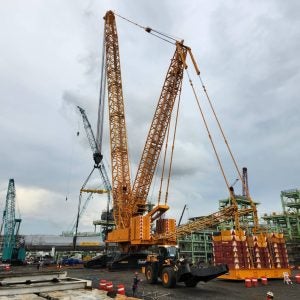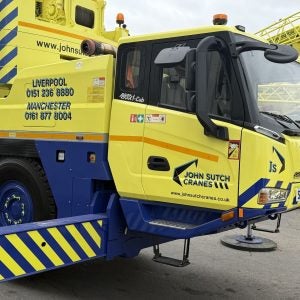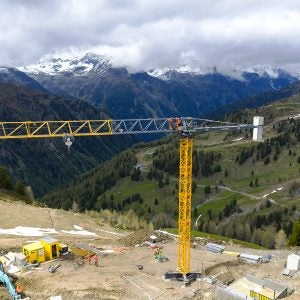Knuckleboom manufacturers in Europe all tell the same story: last year’s building sector started falling apart in Spain, but the devastation soon covered vast swathes of the continent. Ove Trankjær, CEO of Denmark’s HMF, says, “Our biggest quarters in 2008 were the second and fourth. They were almost equal. The third quarter is always low, because everyone in Europe takes their holidays around then. That happened in 2008, as normal.
“We still had a big backlog of orders throughout 2008. At the beginning of October 2008, order intake dropped dramatically. Orders have been at the same low level ever since. There is no sign of an upturn, so far. In the first quarter of 2009, turnover was down by 30%, compared to the same quarter in 2008.”
Giovannio Fassi, managing director of Italy’s Fassi, points out that the Spanish market is ‘surely the worst’ and says, “From the first to the third quarter of 2008 we had a very similar year to 2007. We noticed a slow down in some markets but overall it was still good. In the fourth quarter we had a serious drop in sales, but we were covered by the order backlog, so for production we didn’t have dramatic changes.
“In the first quarter 2009 sales fell down further more, and continue to fall until today. I think we can expect a drop of about 50% over the rest of 2009. In 2010 and onwards, it is difficult to say, but I think we can expect an increase of 10%–15% based on 2009 sales.”
Palfinger spokesman Harald Boehaker says, “Regions where market activities are very low include Spain, Ireland, Greece, Italy, Russia, and Ukraine.
“Scandinavia, Belgium, the Netherlands, Portugal and Switzerland perform well. This means these markets seem to be stable up to now, although on a much lower level than in recent years. Most models are affected in the same way.”
Harri Ahola, senior vice president of global solutions at Finland-based manufacturer Hiab (part of Cargotec) says, “The first three quarters were reasonable compared to 2007. There was a slight drop in sales in the last quarter, compared to the same period in 2007: briefly, there was a 10% drop.
“The question to ask is, ‘What indicators drive the market?’ If you follow the truck industry, you can see the trends there. As truck sales fall, sales of truck mounted cranes follow. Other indicators are the construction business, and new housing starts. The future can only be predicted from these figures: if you want to look at what to expect in 2009 or 2010, it will follow those trends.”
The chart on p29, showing commercial vehicle sales in Europe since the start of 2007, demonstrates Ahola’s point. While there are regular short troughs corresponding to holidays, there is a marked downward trend in sales across the region, starting in September 2008. In the space of five months, truck sales have almost halved, and look to be continuing on their way down. Without new trucks to be mounted on, there is little hope of an immediate recovery in truck mounted crane sales.
Through the good times at the start of 2008, one of the pressures on manufacturers was the rising price of the speciality steels, like SSAB’s Weldox, used to build knuckleboom cranes. According to metals experts Metal Bulletin Research, steel plate prices rose from EUR993 a tonne in the last quarter of 2007, to EUR1,482 in the third quarter of 2008 (see chart below). Since then, prices have fallen to EUR822 per tonne.
When sales abruptly dropped, steel prices remained high, and the pressure on margins was magnified. However, there is some relief for manufacturers here. Adam Panayi, of Metal Bulletin Research, says, “Since the record highs in steel plate prices in October 2008, a combination of falling demand (as a result of the world economic downturn) and falling raw material costs (as steel makers have sought to cut back production) have seen prices lose all support.
“At present they stand at nearly a third of their highest value, and while we believe that prices have now broadly reached a bottom, as producers margins are now paper thin, we do not expect any sort of sustained recovery before the end of 2009. While high value niche market steel such as Weldox tend to be slightly more immune to the vagaries of the markets than commodity grade steels like plate, as they are more likely to be purchased on a contractual basis rather than on the spot market, we have seen prices for other speciality steels show lagged falls to reflect what is happening in the rest of the sector.”
Alarming reports
The financial reports of two global, listed manufacturers paint a fuller picture of the dramatic changes during 2008. Austria-based Palfinger’s lavishly presented annual report carries a grim message on its cover, “Times are tough,” but goes on to promise that, “We are tougher.” Inside, the company reminds readers that its previous full-year results had showed that 2007 was its third record year in a row, with revenues up by 19% to EUR695.6m. By November, the company was warning that, “The results for the first three quarters still showed an increase thanks to the strong first half, but the outlook was restrained.”
Later in the same month, Palfinger recalls, “Demand in the core markets continued to be on the decline, with no recovery in sight for the following months.”
The global spread of the company’s crane sales, with customers as far afield as Brazil and China, means its sales figures give a good indication of the overall health of the world knuckleboom sector.
Over the full year, Palfinger’s crane sales only dipped slightly, down 1.8% from EUR510.14m for the full year 2007, to EUR500.9m for the full year 2008. The trend in sales is far more alarming when looked at on a quarterly basis. Palfinger’s crane segment generated revenues of EUR143.72m and EUR147.23m in the first two quarters. In the third quarter, revenues dropped by almost EUR40m, to EUR108.39m, before falling further, to EUR101.55m in the final three months of the year.
Margins followed the same trend. Earnings before interest and tax (EBIT) margins were steady, at just above 20%, for the first six months of the year. In the third quarter, EBIT margins dropped first by a third, from 20.1% to 13.3%; in the last quarter, they were almost halved again, to 7.4%.
The report says, “The development of both revenue and earnings reflects the weakening of the market environment. Markets whose upswing had resulted mainly form the real estate industry or raw materials production were hit particularly dramatically. As the financial crisis has made it more difficult to obtain loans, planned projects are being postponed and increasing caution is being taken when it comes to new investments.”
A glance back at the company’s EBIT over the last five full years gives another striking demonstration of the tumult that hit the industry in 2008. Much of Palfinger’s growth has been inorganic, so any comparison should be made with caution. However, in 2004, the company’s EBIT was EUR41.69m; in 2005 it rose to EUR65.14m; it hit EUR77.02m in 2006; in 2007, it reached EUR99.63m. Then, in 2008, it fell to EUR69.08m, lower than the last two years, and almost as low as in 2005.
Finland’s Cargotec, which owns knuckleboom manufacturer Hiab, alongside port lifting and handling business Kalmar and marine crane manufacturer MacGregor, offers a similar global perspective. It released its first quarter 2009 results as this article was being written. The company only breaks down its results by brand, not by equipment type, so the figures for Hiab include demountables and other equipment, as well as cranes.
Cargotec received group orders in the three months to 31 March, 2009 worth EUR456m, a fall of 61% from the same period in 2008, when Kalmar and MacGregor had both enjoyed a record high. Hiab orders in the first quarter of 2009 were EUR138m, down 40% from EUR228m in the first three months of 2008.
Hiab’s order book is about two months, Cargotec says. The order book stood at EUR148m at the end of March, down 10% from EUR164m at the end of 2008. Sales in the first quarter were EUR153m, down 34% from EUR230m in the same period in 2008. The fact that order intake in the quarter fell faster than sales, does not suggest an upturn is likely to be coming immediately.
The company says the sales decline at Hiab, “was attributable to the low order intake in the final quarter of 2008 and during the reporting period,” and that it, “reflects the general uncertainty in the load handling equipment market and customers’ lack of willingness to invest.”
Hiab and Palfinger, and other companies interviewed in this feature, have had to make tough decisions to adjust capacity to meet demand. These have included redundancies, extended factory shutdowns and shift reductions. Even then, Cargotec says, “Hiab was unable to adjust its operations to the plunge in demand quickly enough.”
In the first quarter of 2008, Hiab had made an operating profit of EUR17.7M; in the most recent quarter, it made a loss of EUR8.1m. In percentage terms, operating profit fell from 7.7% in the first quarter of 2008, to a 5.3% operating loss in the first quarter of 2009.
Keep looking forward
In a market this troubled, what can manufacturers do to limit the damage to their businesses? The cost cutting that Cranes Today has detailed over recent months is one answer. Beyond that, Ove Trankjær says, “You need to keep looking forward.”
The HMF CEO explains, “We’re continuing with our research and development strategy. We recently launched a new range of 13tm to 24tm cranes. As we update the mid-range cranes, we’ve launched a new fly jib that offers extra capacity at further reach. We have more new product launches planned this year.
“We’re doing some work with new safety systems, in order to make sure they meet the new stability function requirements of the new European norm, EN 12999, which comes into effect at the start of 2010. We are happy that for more than 10 years we have offered and supplied the HMF EVS stability system, which already fulfils the demands in CEN EN 12999. We just have to offer the HMF EVS solution on all crane models delivered from January 2010.”
Trankjær is not alone in looking to the future. Giovanni Fassi says, “Our R&D activity hasn’t suffered from the market situation. In fact, we are still investing in this sector, without modifying any set up or people or organisation. We’re launching new products like the new FX 500, F295A, F335A and the new F145AS, a ‘baustoffkrane’ [block handling crane] for the German market. We are developing more new products and features that we will launch soon.”
Hiab is also looking at the special demands of a particular country’s market. Harri Ahola says, “The newest model we’ve launched is the new crane for China, the ST 173-063. The new ST name for the new family of cranes stands for ‘Stiff Telescopic’. Instead of the knuckleboom cranes we’ve traditionally made, this is a stiff boom crane, similar to the type of crane more generally used in Asia. It’s a 17tm crane, with a 6.3t hoist. This is a completely new crane.
“We’ve seen that this type of crane has been growing in China, but that growth has been among local manufacturers. That’s why it is important for us to be local there. The new crane is closer to the requirements of the local market, and to competitor products there. You can’t compete by offering something that’s far out of the range of what’s there already.
“The development of the new crane has been based on a customer driven approach. We’ve conducted market studies in China, not brought in something that we’ve developed in Europe. But, we’ve used our long experience in developing cranes, both production wise, with things like the hexagonal boom, and in terms of materials like the high tensile steel. We’ve combined our new knowledge with a local product.
“Other recent new models include an 80t crane launched last autumn, and several new cranes in a new range designed to be used as MEWPs. In 2009, we have already introduced a number of models, ranging from 20tm to 40tm, approved for the new personnel basket norm, EN280, (MEWP). Last year we launched the first three factory built models with MEWP approval: XS 122, 144 and 166 HiPro.”
Effer, now owned by CTE, is also looking to expand out of its traditional markets. Speaking to Cranes Today at Intermat, CTE France president Christian Cazabat said, “Effer is strong in big machines, over 40tm maximum capacity. Effer launched a new rail wrecker machine model 3000 (nearly 300tm) used by the Danish railways as a recovery and maintenance unit. On our stand at Intermat, we introduced our model 1750.” Effer claims this is the biggest knuckleboom crane ever sold in France.
Effer’s background is in big, high technology machines. However, Cazabat says, “The CTE Group and Effer brand will, in the very near future, be launching cranes in the crucial small-medium sector, between 10tm–20tm.
“Our new LSV range of 13tm and 15tm cranes will have, as standard, a proportional and multifunctional distributor made by Danfoss. When required, they could be retrofitted with radio control kit or a ‘stand up’ platform control point. These options cost a few thousand euros more, but are important working accessories.”
The company also showed its latest 1355, with nine hydraulic extensions equipped. The crane is fitted with Effer’s patented CrossStab diagonal stabiliser system. Effer says this guarantees full stability at 360°. Cazabat says, “The 1355 on show was equipped with fly jib and winch. The end user bought this particular unit to be used as a multiple purpose crane, both as a recovery unit in case of big road accidents and for handling special loads.”
Maintaining relationships
It’s often said that you sell the first crane on features, and the second on service. Terex’s knuckleboom crane brand, Atlas, was recently moved from the US-owned group’s roadbuilding and construction segment into its crane’s division. Lee Maynard, the company’s UK general sales manager for knuckleboom cranes, says, “Companies are now looking more and more to whole life costs. We continue to focus on our service and support operations which have now become an important differentiator between Terex and our competitors.
In addition to our service and support focus, we have made maintenance and repair contracts an integral part of the business as well.
“We pride ourselves on our products and after sales service, which now even includes a motorbike-based repair service in London to beat the traffic. We are committed to delivering responsive global support and meeting our customer needs with a full range of equipment.”
Hiab’s Ahola says, “Aftersales and service are part of our long-term plan. For several years, we’ve been increasing our focus on service, before the downturn in the market. We’re a big group, and we’ve made internal changes to benefit from that. Traditionally, service had been done locally; now, we’re integrating service across the group. That means we can reach further, and do more to use our organisation across the group.
“It’s been a cornerstone of the group to have a ‘one company’ approach. We’re utilising the service capacity the group has, and harmonising the group internally.
“For the customer, that means we can offer a global presence. For example, in some countries, we might not have had a Hiab presence, but Kalmar was there and co-operation can be found. In each country we go through our service networks and how we can cooperate there.
“Especially in Europe, we look for new ways to cooperate and find synergies.
A good example of this approach is Finland, where Kalmar’s workshop is located in central Finland, and Hiab products have also started to be repaired and maintained here.”






